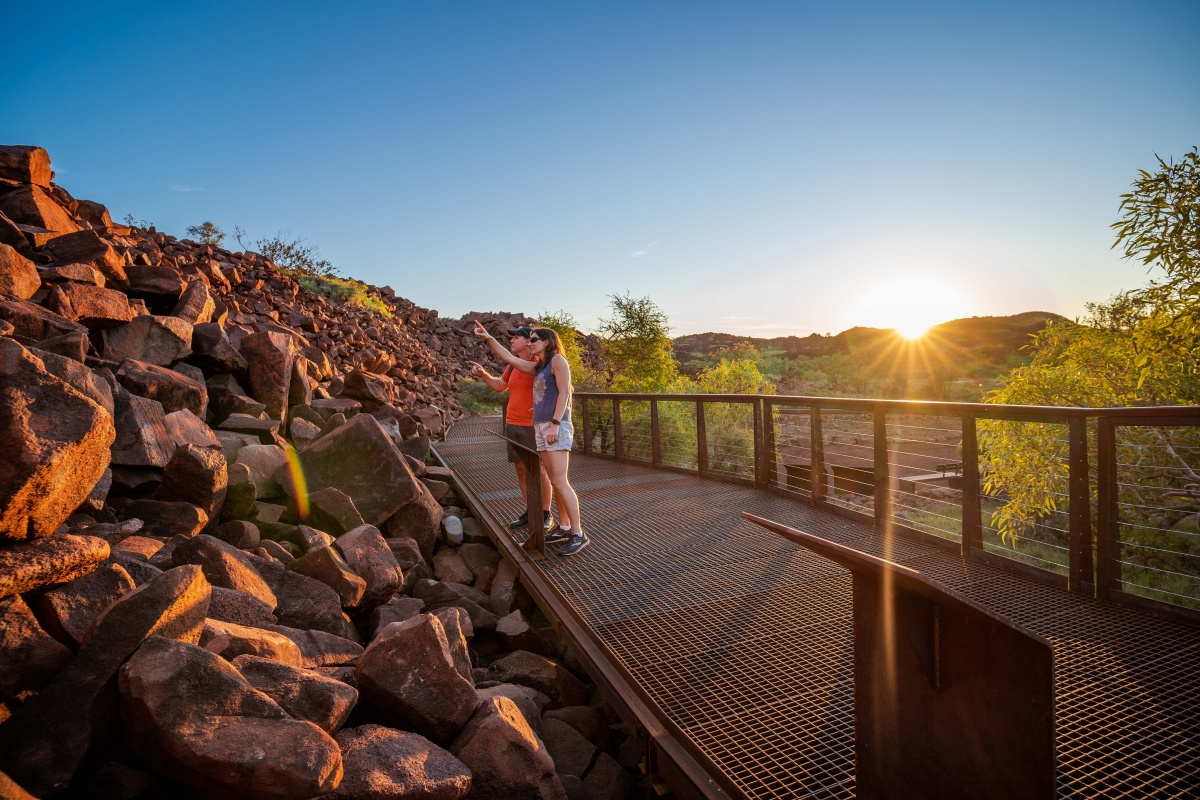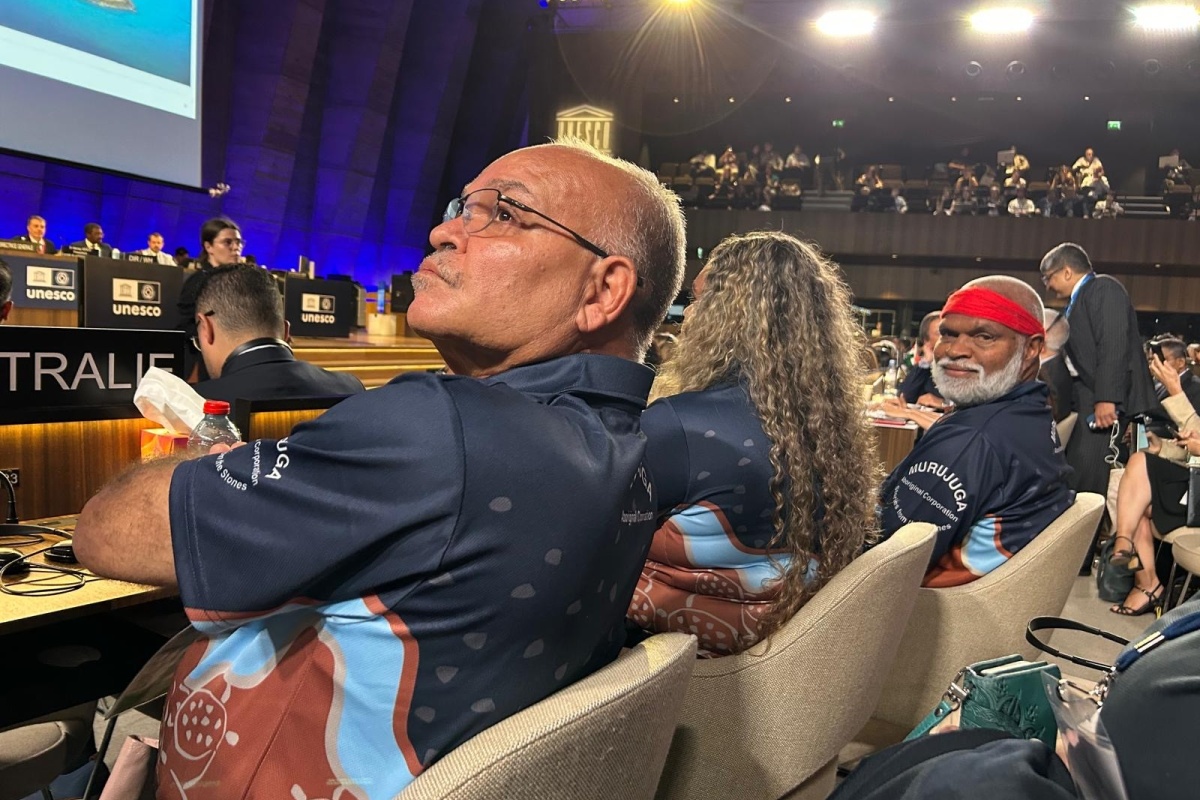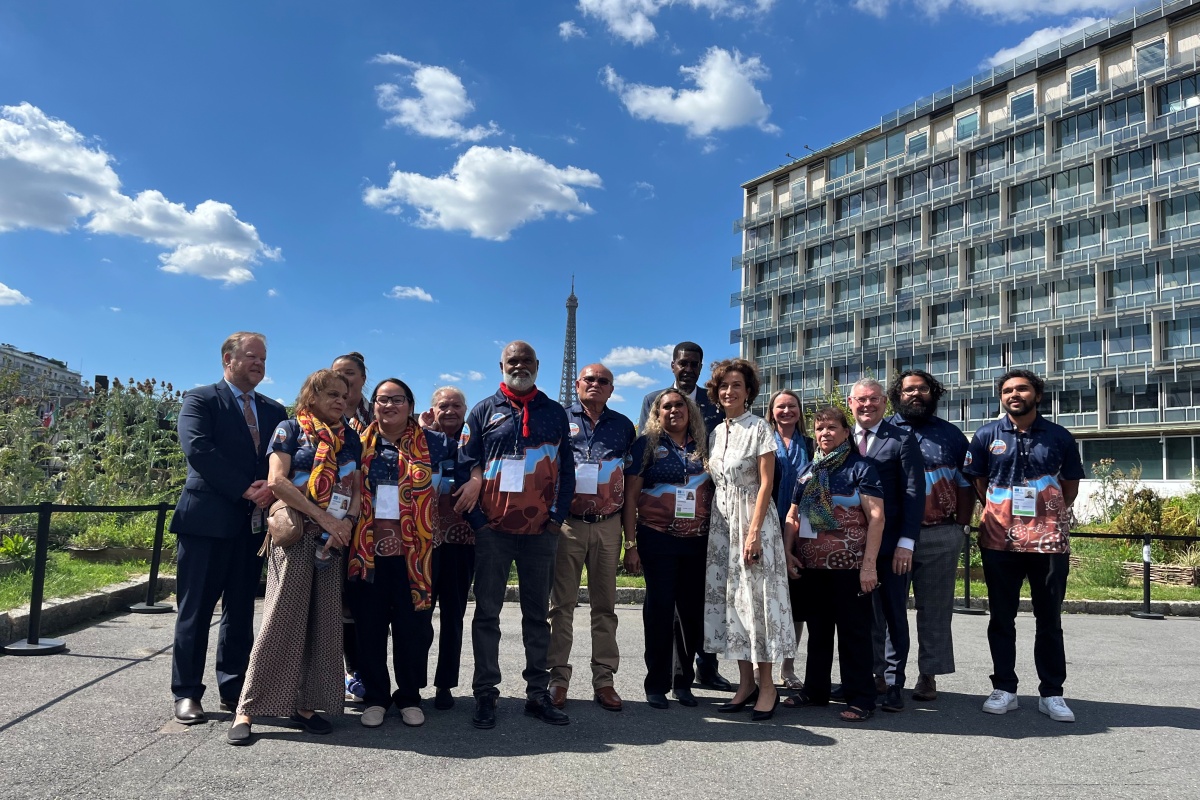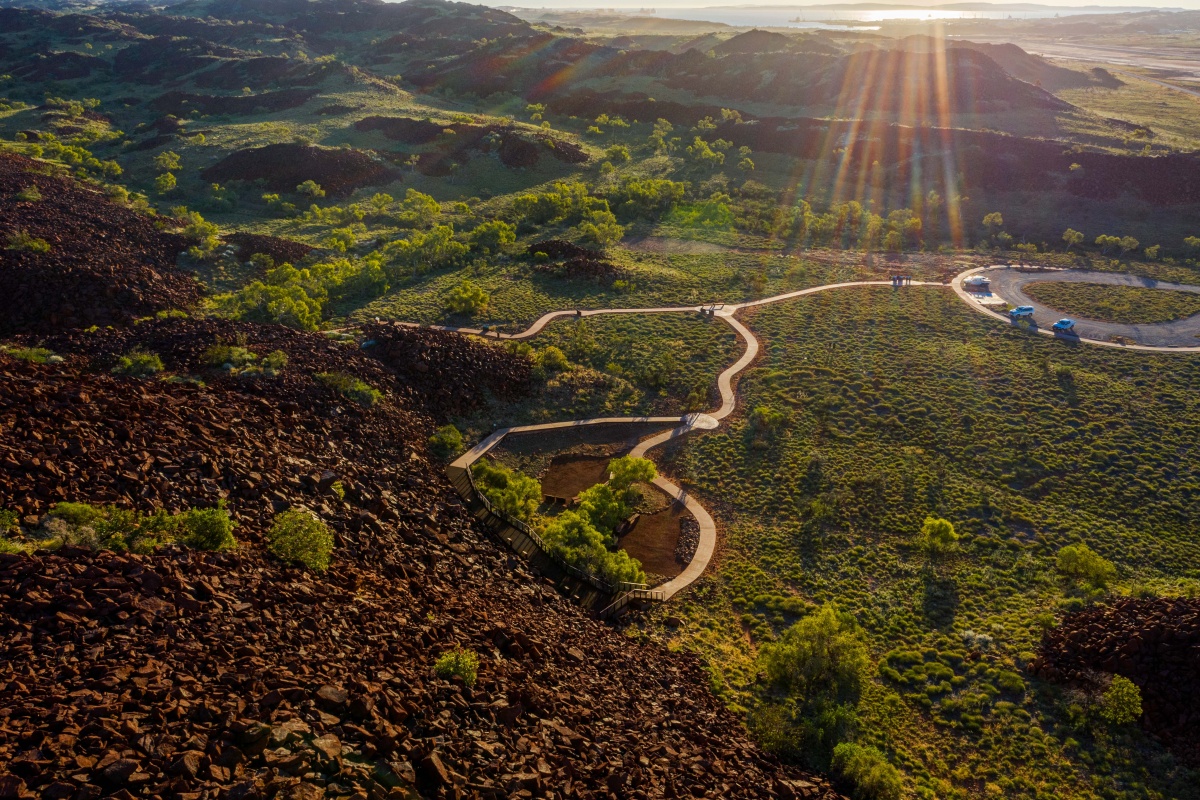Murujuga, in the State’s north-west, is renowned for its dense concentration of archaeological and spiritual sites that reflect the interaction between people and place over thousands of generations.
Murujuga is shaped by the Lore – rules and narratives put in place to create the Country – and the enduring presence of the Ngarda-Ngarli, Traditional Owners and Custodians of the site. The property holds profound cultural and spiritual significance, reflecting over 50,000 years of continuous care and management by Traditional Law that has adapted to the changing needs of country over periods of dramatic climatic and environmental change.
Its extraordinary rock art assemblage records a complex system of Lore and Traditional Law, features unique motifs, and demonstrates artistic and technical mastery.
Murujuga Cultural Landscape was inscribed on the World Heritage List on 11 July 2025, recognising its Outstanding Universal Value and acknowledging the international significance of Ngarda-Ngarli culture and the unique archaeological and spiritual values of the cultural landscape. After Budj Bim in Victoria, the Murujuga Cultural Landscape is only the second World Heritage property in Australia to be inscribed solely on the basis of Aboriginal cultural values.
SIGNIFICANT LANDSCAPE
The World Heritage nomination was led by the Murujuga Aboriginal Corporation (MAC), representing the Ngarda-Ngarli as the first-nations Traditional Owners and Custodians, and fulfilling the long-term determination of Elders to have the significance of the landscape acclaimed on the global stage.
The decision to inscribe the Murujuga Cultural Landscape on the World Heritage List was made at the 47th meeting of the World Heritage Committee.
The current chair of the Murujuga Aboriginal Corporation, Peter Hicks, was at the World Heritage Committee meeting, together with MAC directors, rangers and staff.
Mr Hicks reflected on the significance of the occasion and his experience saying the journey to World Heritage status had taken many years of advocacy by Ngarda-Ngarli.
“It was a big moment to have the dream realised for the Elders and the community,” Mr Hicks said.
“In the lead up to the World Heritage meeting we were nervous. Having not been in this kind of forum previously we did not know what to expect.”
It was important to everyone involved that that Murujuga Cultural Landscape have the highest level of protection.
“That is why our people have fought so long for this,” Mr Hicks said.
MAKING A STATEMENT
The World Heritage Committee meeting was held in Paris at the headquarters of the United Nations Education Science and Culture Organisation (UNESCO). The building is a few blocks from the Eiffel Tower in central Paris.
“With all the negotiations I didn’t see much more of Paris than the inside of the UNESCO building,” Mr Hicks said.
“We knew it was important to be there in person to explain the scientific basis for the protections for Murujuga that we have in place.
“There were a lot of tense moments and discussions that took place to get the listing over the line and convince other delegations of the scientific evidence. We were having bilateral talks right up until the day of the decision.”
Decisions to inscribe new properties on the World Heritage List are made by the 21 nations elected to the World Heritage Committee. During the Committee session, on Friday 11 July, when the inscription of the Murujuga Cultural Landscape was discussed, the nomination dossier and evaluation was presented by the expert advisory body on culture, the International Council on Monuments and Sites (ICOMOS) and then discussed amongst the Committee member nations. According to protocol, the Australian delegation can only make a statement if it is invited by the Committee to do so.
“Even when the Committee started to talk and listening to what ICOMOS presented I was nervous,” Mr Hicks said.
“I was thankful for the role that Kenya took to support the inscription. To have the support of other countries, like Kenya, who have an understanding of First Nations people, but also have the technical and scientific background to understand the scientific information we were discussing and be able to drive that message on the Committee.
“You could see other nations then also understand what the nomination meant. This was so important to have this understanding and be able to deliver the World Heritage listing for the Elders.”
GLOBAL RECOGNITION
When the president of the World Heritage Committee brought down the gavel, signalling that a decision had been made to inscribe the Murujuga Cultural Landscape on the World Heritage List, there was a cheer and great applause.
The Australian delegation was given the right to speak. Belinda Churnside, MAC Board deputy chair, greeted the world community in her native language, Ngarluma.
"Wayiba nyindaguru. Ngaliguru yijala milbama, barnumbangu Murujuga Ngurra. We have come here together and from far away, from the Murujuga lands. This has been a long-awaited journey and a fight for our Elders, our gurdambara, our old people and we are grateful to receive this recognition on a global scale." – Address by MAC Board Deputy Chair Belinda Churnside to the World Heritage Committee meeting
“For Belinda to speak in language, taking the lead that way, really helped people to understand that language and lore are alive and that is what the nomination is all about,” Mr Hicks said.
“I hardly know what I said that day. I was so nervous talking, I just spoke from the heart.”
Mr Hicks also made a short speech at the Committee meeting.
“I would like to acknowledge the community of Roebourne, Western Australia, for this nomination to be put forward for such sacred lands of our area and acknowledge Elders past and present and the members of the delegation that have been here today to put this world leading nomination in place.”
TIME FOR CELEBRATIONS
That evening the Australian Ambassador to UNESCO, Greer Alblas, hosted a celebration at the Australian Embassy.
“Afterwards, the MAC delegation went to the embassy and had some quiet time to sit and reflect on how it had all come together how it did,” Mr Hicks said.
“This was a big moment for the Aboriginal community, not only for those who travelled to Paris.”
There were parallel celebrations on the night of the decision in Roebourne and MAC plans to hold a celebration with the whole community together.
STANDING TOGETHER
“Now that Murujuga is on the World Heritage List, we now need to sit with the team, as we are new to this, and work with other government bodies to understand what practically needs to happen next,” said Mr Hicks.
“One push is for MAC rangers to have a strong role and powers to make sure the landscape is properly protected. We will have joint management over the islands of the Dampier Archipelago, and this means growing the ranger team and skills. The rangers are our future – when we are gone, they will be left to look after the landscape, so we need to nurture and support them in this role.
“We are grateful for the support of the Commonwealth and the State along this journey. We also recognise industry for the contributions that they have made, standing with us. Working together we can demonstrate that both heritage and industry are able to co-exist.
“The legal status that we now have in place provides greater protections. The Corporation will do everything to keep that status and to protect Murujuga. The Murujuga Rock Art Monitoring Program will continue, and should future monitoring show some form of deterioration, MAC will be the first standing on the doorstep and asking questions to protect our heritage.
“This was such a powerful moment for Murujuga. I really hope that other Aboriginal communities have the opportunity to have their Country recognised in this way.”
The journey to World Heritage status
16 January 2003
Ngarda-Ngarli and the WA Government sign the Burrup and Maitland Industrial Estates Agreement (BMIEA) Additional Deed which includes a section about consideration of a World Heritage nomination.
19 April 2006
Murujuga Aboriginal Corporation (MAC) is incorporated as the approved Corporate Body to administer the contractual obligations of the BMIEA.
7 January 2013
MAC and WA Government (Department of Environment and Conservation) sign a joint management agreement for Murujuga National Park.
27 Aug 2018
The WA Government commences a UNESCO World Heritage nomination process for the Burrup Peninsula and surrounds, following formal support from Traditional Owners.
1 July 2019
The WA Government transfers ‘Site L’ as the first of seven previously designated industrial sites into the Murujuga National Park conservation estate.
15 Feb 2019
WA Government releases the Murujuga Rock Art Strategy, which is implemented by MAC and the WA Government.
28 Jan 2020
Tentative List Submission for the Murujuga Cultural Landscape is formally transmitted by the Australian Government to the UNESCO World Heritage Centre – the first step in the World Heritage nomination process.
26 Aug 2020
Visitors to Murujuga National Park are given improved access to viewing culturally significant rock art with a new walking trail and signage – the $1.3m Ngajarli Trail.
10 Feb 2023
The Australian Government nominates Murujuga Cultural Landscape for inscription on the World Heritage List. The formal nomination was submitted to the UNESCO World Heritage Centre in late January 2023.
29 Feb 2024
The WA Government signs a Statement of Intent to guide an agreement on the management, protection, and conservation of Murujuga country, also known as the Burrup Peninsula and Dampier Archipelago.
23 May 2025
The WA Government and MAC release the latest report from a major scientific program monitoring the condition of rock art on Murujuga in the Burrup Peninsula and Dampier Archipelago.
17 July 2025
Murujuga Cultural Landscape is inscribed on UNESCO’s World Heritage List at the 47th session of the World Heritage Committee in Paris.





